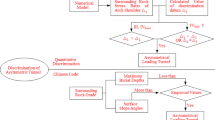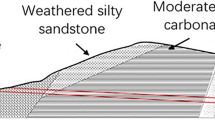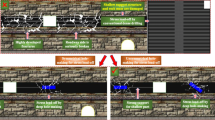Abstract
Asymmetric stress occurs in shallow buried highways and railway tunnels. Due to asymmetricalloading, the design process of the tunnel is different from a regular tunnel. Chinese code for designing railway tunnel contains empirical values for different grounding rock to facilitate engineering judgement of asymmetrical loading tunnels based on the slope angle of surface and the burial depth of the tunnel. However, when calculating the asymmetric stress, there seem to be no quantitative criteria for estimating the asymmetric stress. Thus, in this work we create a numerical model to better evaluate the asymmetric stress ratios in different rock types. Our results demonstrate for surrounding rocks of grade V with poor stability, an asymmetrical loading conditions should be considered specifically when the stress ratio at the spandrel is higher than unity. For surrounding rock with grade IV in which stability slightly increases we found that the tunnel is asymmetrical once the stress ratio at the spandrel reaches to above 2 − 3. For the grade IV with a higher stability, an asymmetrical loading should be considered in the design when the stress ratio reaches to 3 − 4. For rock with grade III with the maximum stability only when the stress ratio is higher than 7 − 8, the asymmetrical loading conditions should be considered. We found that for grades III, IV, and V, the stress ratio of sidewall is about unity under various slope angles and burial depth. Importantly, we show that the stress ratio at the sidewall cannot be used to make judgements on whether the shallow buried tunnels are asymmetrical loading conditions. Our results have practical implications in design, safety, and risk analyses of tunnels.
Similar content being viewed by others
References
Areias P, Reinoso J, Camanho PP, Cesar de Sa J, Rabczuk T (2017) Effective 2D and 3D crack propagation with local mesh refinement and the screened Poisson equation. Engineering Fracture Mechanics 189:339–360, DOI: 10.1016/j.engfracmech.2017.11.017
Ching J, Yang ZY, Shiau JQ (2013) Estimation of rock pressure during an excavation/cut in sedimentary rocks with inclined bedding planes. Structure Safety 41(3):11–19, DOI: 10.1016/j.strusafe.2012.10.006
Cho SH, Kim J, Won J, Kim MK (2017) Effects of jack force and construction steps on the change of lining stresses in a TBM tunnel. KSCE Journal of Civil Engineering 21(5):1135–1146, DOI: 10.1007/s12205-016-0391-y
Gao SM, Sun Y, Wang W (2017) Propagation of cracks in the secondary lining of tunnels subjected to asymmetrical pressure and a safety evaluation. Indian Geotechnical Journal 47:1–12, DOI: 10.1007/s40098-016-0216-4
He M, Peng Y, Zhao S (2015) Fracture mechanism of inversed trapezoidal shaped tunnel excavated in 45°o inclined rock strata. International Journal Mine Science Technol 25(4):531–535.
Jeong SS, Han YC, Kim YM, Kim DH (2014) Evaluation of the NATM tunnel load on concrete lining using the ground lining interaction model. KSCE Journal of Civil Engineering 18(3):672–682, DOI: 10.1007/s12205-014-0597-9
Lei M, Peng L, Shi C (2015) Model test to investigate the failure mechanisms and lining stress characteristics of shallow buried tunnels under unsymmetrical loading. Tunneling & Underground Space Technology 46:64–75, DOI: 10.1016/j.tust.2014.11.003
Lei M, Peng L, Shi C, Ding Z (2013a) Calculation of surrounding rock pressure on shallow buried tunnel using linear and nonlinear failure criterion. Automation in Construction 37:191–195, DOI: 10.1016/j.autcon.2013.08.001
Lei M, Peng L, Shi C, Wang L, Liu Z (2013b) Model research on failure mechanism and lining stress characteristics of shallow buried tunnel under unsymmetrical pressure. Journal of Central South University 44(8):3316–3325.
Liu X, Chen H, He C (2017) Model test and stress distribution law of unsymmetrical loading tunnel in bedding rock mass. Arabian Journal of Geosciences 10(7):184, DOI: 10.1007/s12517-017-2949-5
Liu XJ, Zhang YX (2011) Analysis of reasonable excavation sequence and stress characteristics of portal section of shallow tunnel with unsymmetrical loadings. Chinese Journal of Rock Mechanics & Engineering 30(2):3066–3073
Liu XJ, Zhang YX, Huang D (2011) Load calculation method of shallow tunnel under unsymmetrical loadings in broken surrounding rock. Journal of Civil Architectural & Environmental Engineering 33(5):28–33
Liu Y, Zhang X, Li J, Zhang Z, Zhang H (2019) Performance assessment of arch-shaped primary lining during construction in weak rock shallow-buried tunnel. KSCE Journal of Civil Engineering 23(1):433–443, DOI: 10.1007/s12205-018-1541-1
Nie L, Yu QY (2007) Geotechnical numerical method. Jilin University Press, Changchun, China, 63–65
Nomikos PP, Yiouta-Mitra PV, Sofianos AI (2006) Stability of asymmetric roof wedge under non-symmetric loading. Rock Mechanics & Rock Engineering 39:121–129, DOI: 10.1007/s00603-005-0058-3
Panji M, Koohsari H, Adampira M (2016) Stability analysis of shallow tunnels subjected to eccentric loads by a boundary element method. Journal of Rock Mechanics and Geotechnical Engineering 8(4):480–488, DOI: 10.1016/j.jrmge.2016.01.006
Rabczuk T, Belytschko T (2004) Cracking particles: A simplified meshfreemethod for arbitrary evolving cracks. International Journal for Numerical Methods in Engineering 61(13):2316–2343, DOI: 10.1002/nme.1151
Rabczuk T, Belytschko T (2007) A three-dimensional large deformation meshfree method for arbitrary evolving cracks. Computer Methods in Applied Mechanics and Engineering 196(29–30):2777–2799, DOI:10.1016/j.cma.2006.06.020
Railway administration of the People’s Republic of China (2017) Code for Design of Railway Tunnel TB1003-2016, J449-2016, China Railway Publishing House, Beijing, China
Ren H, Zhuang X, Rabczuk T (2017) Dual-horizon peridynamics: A stable solution to varying horizons. Computer Methods in Applied Mechanics and Engineering 318:762–782, DOI: 10.1016/j.cma.2016.12.031
TB 10003-2016 (2017) Code for design of railway tunnel. TB 10003-2016, Railway Administration of the People’s Republic of China, China Railway Publishing House, Beijing, China
Wang SY, Sloan SW, Tang CA (2012) Numerical simulation of the failure mechanism of circular tunnels in transversely isotropic rock masses. Tunneling & Underground Space Technology 32(11):231–244, DOI: 10.1016/j.tust.2012.07.003
Yang GB, Zhang CP, Cai Y, Min B (2019) Complex analysis of ground deformation and stress for a shallow circular tunnel with a cavern in the strata considering the gravity condition. KSCE Journal of Civil Engineering 23(9):4141–4153, DOI: 10.1007/s12205-019-0068-4
Zhang ZX, Xu Y, Kulatilake PHSW (2012) Physical model test and numerical analysis on the behavior of stratified rock masses during underground excavation. International Journal of Rock Mechanics & Mining Sciences 49:134–147, DOI: 10.1016/j.ijrmms.2011.11.001
Zhang H, Zhang Z, Huang H (2009) Model test on mechanical behavior of two shallow-buried closely-spaced tunnels at different elevations under unsymmetrical load. Journal of Tongji University 37(2):169–175
Zhou S, Zhuang X, Zhu H, Rabczuk T (2018) Phase field modelling of crack propagation, branching and coalescence in rocks. Theoretical and Applied Fracture Mechanics 96:174–192, DOI: 10.1016/j.tafmec.2018.04.011
Zuo CQ, Chen JP, Liu H (2011) Load calculation method of tunnels with shallow buried depth and unsymmetrical pressure in regions of weak fissured surrounding rock. Advanced Materials Research 243–249:3364–3369, DOI: 10.4028/www.scientific.net/AMR.243-249.3364
Acknowledgements
This work has been funded by the National Key Research and Development Program of China (No: 2018YFC1800900), the National Natural Science Foundation of China [Grant numbers: 41772253, 51974126, 51774136], and the Key Natural Science Foundation of Hebei Province (D2017508099). The authors also thank Jilin University (JLU) for the Program for JLU Science and Technology Innovative Research Team (JLUSTIRT-2019TD-35) and the Engineering Research Center of Geothermal Resources Development Technology and Equipment, Ministry of Education, China.
Author information
Authors and Affiliations
Corresponding author
Rights and permissions
About this article
Cite this article
Yu, Q., Song, Z., Du, C. et al. Analysis of Asymmetric Stress Ratio in Shallow Buried Tunnels. KSCE J Civ Eng 24, 1924–1931 (2020). https://doi.org/10.1007/s12205-020-2063-1
Received:
Revised:
Accepted:
Published:
Issue Date:
DOI: https://doi.org/10.1007/s12205-020-2063-1




